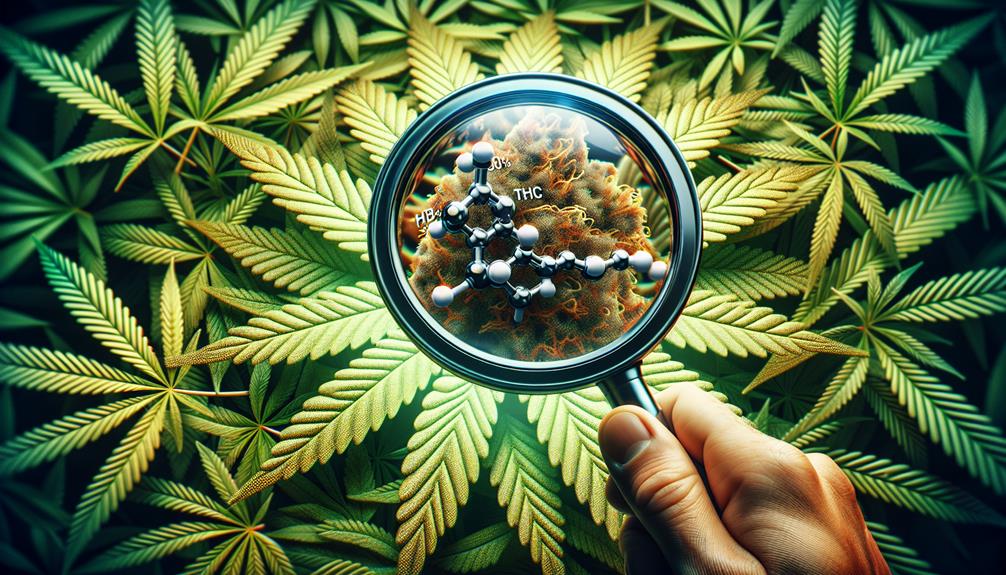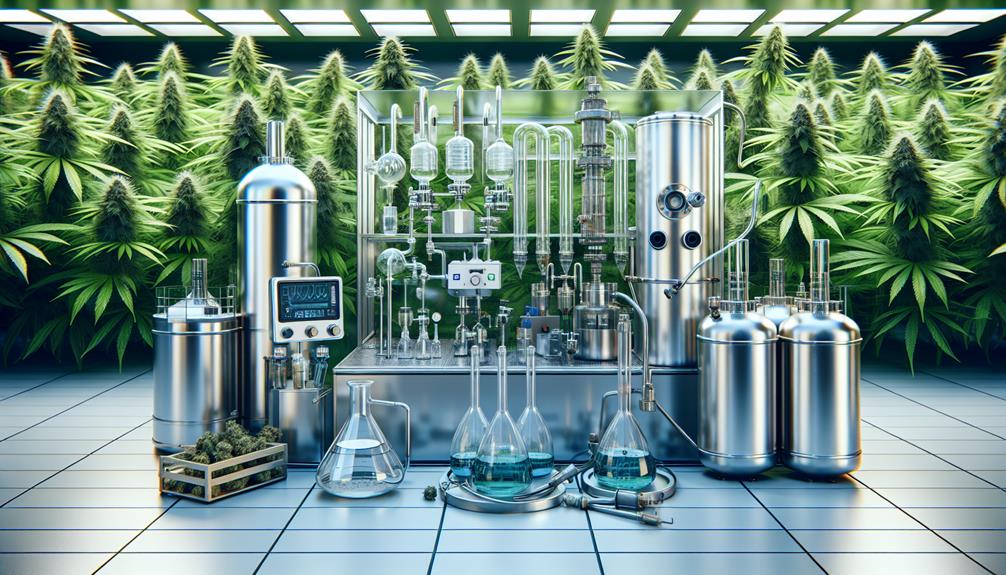Navigating the labyrinth of CBD product labels can feel like deciphering an ancient code—where each symbol and term holds a significant meaning that affects your experience. You're not alone if you've ever felt overwhelmed while trying to understand the contents of a CBD product. With terms like full-spectrum, broad-spectrum, and isolate, it's vital that you're equipped with the knowledge to make informed decisions. As you scan the label, you'll need to look beyond the eye-catching graphics and focus on the details that truly matter: the type of CBD, its concentration, the presence of THC, and the promise of third-party testing. Moreover, don't overlook the importance of additional ingredients that could impact your health. To ensure you're getting the quality you're paying for, you'll want to know exactly what to look for—and what to question. Stick with me, and I'll guide you through the intricacies of CBD labels, helping you to become an informed consumer poised to make the best choices for your wellness.
Understanding CBD Terminology
To navigate the landscape of CBD products effectively, it's crucial to grasp the specific terminology used on their labels. CBD and THC are distinct cannabinoids from the cannabis plant. THC is psychoactive, inducing the high associated with marijuana, whereas CBD doesn't cause such effects. The type of CBD product you choose will depend on the desired outcomes and legal stipulations, given that hemp plants contain no more than 0.3% THC.
Understanding the difference between full-spectrum, broad-spectrum, and CBD isolate is vital. Full-spectrum CBD includes all cannabis plant compounds, with up to 0.3% THC in hemp-derived items. Broad-spectrum CBD encompasses all elements except THC, or it contains only trace amounts. CBD isolate, meanwhile, is the purest form, free from other hemp compounds.
Recognizing the entourage effect is also key. This phenomenon suggests that using the full array of cannabinoids and compounds together may yield greater benefits than individual components alone.
Lastly, always check the certificate of analysis (COA), a document confirming the exact contents and purity of the CBD product. It's a critical piece of CBD terminology that ensures the item meets quality and safety standards.
Determining CBD Content
When evaluating the potency of a CBD product, start by checking the CBD concentration in milligrams per milliliter on the label. This measurement will give you a clear understanding of the product's strength. To grasp the specific dosage you'll receive, look at the total amount of CBD listed and the recommended serving size.
For instance, a 30-milliliter bottle of CBD oil may contain 1500 mg of CBD. If the serving size is one dropper, or 1 milliliter, and the bottle has a 50 mg/ml concentration, you'll get 50 mg of CBD per serving. It's essential to use the provided dropper or follow the label's dosing instructions to ensure you're consuming the intended amount of CBD.
Remember that different products, like CBD gummies, will have a predetermined amount of CBD per piece. Always ensure that the CBD in milligrams per serving aligns with your needs or the guidelines provided by a healthcare professional.
Assessing THC Levels

While determining the CBD content is crucial for understanding a product's potency, it's equally important to assess the THC levels to ensure legal compliance and meet your personal preferences. You'll want to check the amount of THC listed on the product label to ensure it falls below the federal legal limit of less than 0.3% THC. This threshold is a defining criterion for legality under the 2018 Farm Bill, which applies to hemp-derived CBD products.
When considering full-spectrum CBD options, remember these can contain up to 0.3% THC. While this is a legal amount, it could potentially influence drug test results. If avoiding THC is a priority for you, look for broad-spectrum or CBD isolate products, which typically do not contain detectable levels of THC.
Always consult your state's laws, as they may have stricter regulations regarding the permissible THC content in CBD products. Assessing THC levels accurately ensures that you not only comply with legal standards but also align with your personal usage goals. By paying close attention to the THC content, you can make an informed decision about which CBD product is best suited for your needs.
Identifying Ingredients
Scrutinizing a CBD product's ingredients list is essential for understanding its composition and ensuring it aligns with your health and wellness criteria. A comprehensive ingredient list reveals not only the presence of CBD but also whether the product may contain other ingredients that could affect your body. It's necessary to recognize the specific chemicals and compounds included to anticipate their effects.
When you examine the ingredient list, you're looking for more than just CBD. Be aware of any carrier oils, flavors, colors, or additional active substances that could influence the product's efficacy or cause reactions, particularly if you're sensitive to certain compounds. This vigilance helps you avoid unwanted ingredients and ensures you're choosing a product that's as pure and beneficial as possible.
Furthermore, identifying potential allergens is a critical aspect of reading the label. Allergens can lurk in the most unexpected places, and for individuals with sensitivities, this information is vital. By carefully reviewing the ingredients, you reduce the risk of an allergic reaction and ensure that you're consuming something safe for your unique physiology. Always approach a CBD product with a discerning eye, paying close attention to every component listed to make an informed decision.
Interpreting Extraction Methods

Understanding the extraction method used for a CBD product is crucial, as it significantly influences the purity and overall quality of the product you're considering. When you examine a CBD product label, identifying the extraction method can tell you a lot about what you're getting. CO2 extraction stands out as a superior process—it's safe, efficient, and preserves the hemp extract's cannabinoids and terpenes without leaving solvent residues.
CO2 extraction utilizes supercritical carbon dioxide to isolate and maintain the integrity of cannabinoids and terpenes from the hemp plant. This method ensures a potent and clean final product, free from harsh chemicals. Conversely, some extraction methods deploy solvents like ethanol or butane, which can retain traces in the hemp extract if not properly purged, potentially compromising quality and safety.
When reading a CBD product label, seek out those using CO2 extraction. It's an indication of a manufacturer's commitment to delivering a high-quality product. This method not only ensures a purer hemp extract but also reflects a company's investment in advanced technology and consumer safety. As you become more familiar with extraction methods, you'll be better equipped to select premium CBD products that offer the best in purity and efficacy.
Evaluating Third-Party Testing
When examining third-party testing for CBD products, you must scrutinize the Certificate of Analysis (COA) for detailed lab results. Ensure the COA confirms the advertised CBD and THC levels, and reveals a comprehensive cannabinoid profile for full- or broad-spectrum options. Also, inspect the lab reports for evidence of contaminants, ensuring the product meets purity standards and is free of heavy metals and pesticides.
Understanding Lab Results
Before purchasing a CBD product, it's crucial to review its Certificate of Analysis (COA), which is provided by a reputable third-party laboratory to ensure accuracy and safety. This document confirms product labeling accuracy, including specific CBD and THC concentrations, as well as the complete cannabinoid profile. You should scrutinize the lab charts for evidence of the absence of heavy metals and pesticides, ensuring these are within safe limits. It's essential to match the batch or lot number on the product label with the corresponding third-party lab test results to verify consistency and safety. Be wary of products without accessible third-party lab testing, as they may fall short of quality and safety benchmarks.
Certificates of Analysis
Having scrutinized lab results for safety indicators, it's equally important to evaluate the Certificates of Analysis to confirm the quality and purity of CBD products you consider purchasing. A reliable Certificate of Analysis, obtained through third-party testing, should present a thorough insight into the CBD product's composition. Here's what you should look for:
- Transparency: Access to COA via QR codes or company provision.
- Labeling Accuracy: Verification of listed CBD and THC concentrations.
- Cannabinoid Profile: Full details, including CBDA, CBN, CBG, and CBC.
- Contaminant Analysis: Assurance of no heavy metals or pesticides above safe limits.
- Batch-Specific Data: Ensures consistency and reliability across product lots.
These elements are critical in verifying the claims made on product labels and ensuring that you're getting a pure, high-quality CBD product.
Contaminants and Purity
To ensure the safety and quality of your CBD products, it's imperative to examine the third-party lab testing results for contaminants and purity. A Certificate of Analysis (COA) from a reputable laboratory provides an unbiased testament to the product's integrity. It should reflect not only the cannabinoid profile but also the absence of harmful contaminants.
Here's what to look for in the COA:
| Contaminant Type | Acceptable Level |
|---|---|
| Heavy Metals | Below safety limits |
| Pesticides | Non-detectable or within safe limits |
| Solvents | Below safety thresholds |
| Microbial Contamination | Absent or within acceptable limits |
| Mycotoxins | Not present or below risk levels |
For reputable CBD products, this testing confirms the labeling accuracy for CBD and THC levels, ensuring you're getting what you pay for.
Recognizing Brand Trustworthiness
When assessing the trustworthiness of a CBD brand, always start by checking for a third-party Certificate of Analysis (COA). This document is crucial as it provides an impartial evaluation of the product's contents and purity, and is often accessible through a QR code or a batch number on the product packaging.
Here's a concise checklist to guide you through the intricacies of brand trustworthiness:
- Third-Party Testing: Confirm the COA's authenticity and ensure it matches what's on the product labels.
- Labeling Accuracy: The COA should verify that the product contains the advertised amount of CBD.
- Contaminant Screening: Look for evidence that the product is free from harmful levels of heavy metals and pesticides.
- Quality Sources: Investigate the origin of the hemp and the methods of CBD extraction.
- Reputation & Reviews: Read customer feedback and check for industry certifications.
Frequently Asked Questions
How Do You Read CBD Labels?
You'll want to scrutinize the ingredient breakdown for CBD content, THC levels, and carrier oils. Note the extraction method, as it impacts quality. Check for full-spectrum, broad-spectrum, or isolate to gauge effects. Always verify third-party lab results for safety—this isn't just about legality; it's about ensuring what you're using is pure, potent, and worth your investment. Precision in understanding these details makes all the difference.
How Do I Know if a CBD Product Is Legit?
To ensure a CBD product is legitimate, scrutinize its Certificate of Analysis for lab testing results. Confirm it's been third-party tested—this verifies purity and potency. Check the brand's reputation; established, reputable companies are likelier to offer quality, compliant products. Don't just take their word for it; look for evidence of Certificate Verification and consistent, transparent lab reports. Trustworthy brands will openly share this information.
What Are the Requirements for CBD Labels?
You must check the label for ingredient concentration, including CBD and THC levels, to ensure compliance with federal guidelines. Label transparency is crucial; look for a clear indication of serving size, total CBD content, and a third-party Certificate of Analysis. Verify manufacturing dates and batch numbers to confirm product quality. Always ensure the label evidences thorough testing for contaminants like heavy metals and pesticides for your safety.
What Do the Numbers on CBD Oil Mean?
The numbers on CBD oil indicate its potency. They reflect the cannabinoid profiles, showing the concentration of CBD per volume. You'll need to consider these figures alongside serving suggestions to gauge your intake accurately. They're also tied to extraction methods, which can affect the compound's purity and strength. By understanding these numbers, you're better equipped to choose a product that aligns with your therapeutic needs.
